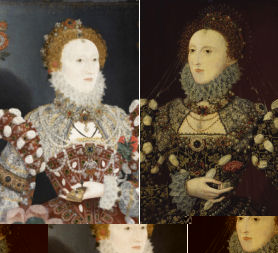Elizabeth I and the Tudor propaganda machine
As two portraits of Elizabeth I go on show in London’s National Portrait Gallery, Tim Lambon analyses the use of art as propaganda in the Tudor era – and beyond.

One of the great things about riding a bike to work in London, is that at lunch time I can nip down to the nation’s galleries for an hour’s contemplation. And what a delight this week.
The National Portrait Gallery – that great repository of images of Britons past and present – has on display two Elizabeths.
Now, being a Richardian and thereby a staunch Yorkist, I am no lover of the Tudors, but there is fascination in the way the they used propaganda. And in the Elizabethan era, although images of the Queen were painted to project political messages about the reign’s wealth, power and stability, they were seldom realistic.
In the Tudor Gallery on the second floor of the National Portrait Gallery, for just one week, two portraits of Elizabeth have been reunited for the first time in nearly 30 years.
One usually hangs down the Thames in the Tate, and the other in the Walker Gallery in Liverpool. They have been brought together as part of the “Making Art in Tudor Britain” project headed by Dr Tarnya Cooper, and it’s remarkable to view them side by side.
It’s all in the pendants
Queen Elizabeth’s Court Painter, Nicholas Hilliard (1547-1619) is best known for his exquisite miniatures, but in these two medium sized portraits can be seen all his attention to detail and more. Their titles, the Pelican portrait (left) with the Phoenix portrait (right), arise from the two different jewelled pendants painted at the breast of the middle-aged queen.
All part of the propaganda machine, the paintings carried very specific messages within a standardised image of the monarch.
The Pelican, for its mythical habit of peeling flesh from its own breast to feed its chicks in hard times, showed Elizabeth as the Mother of the Nation; the Phoenix, forever renewed by fire and believed by the medieval mind to represent re-birth, showed the Virgin Queen as pure and virtuous, dedicating herself to her people and regeneration for the stable dynasty. Sadly for Elizabeth, the re-generation bit never worked.
What is so fantastic are the dresses she’s wearing – encrusted with pearls, slashed with white silk, embroidered with gold braid, hung with gilt collars, strung with enamelled jewels, decorated with precious and semi-precious stones and constructed with ornate arm rings and absurdly narrow waists. Wealth and power reach out and assault even the most casual observer. But what fascinates me, is the delicacy of the gauze over the fine black-work bodice, showing just how advanced textiles had become by the mid-sixteenth century.
Both from same studio
Scientific analysis has revealed that both must have been painted in Hilliard’s studio, as the oak boards used are from the same two trees which originally grew somewhere in the Eastern Baltic – probably Poland. Reversing the face pattern of the Phoenix onto the Pelican portrait shows that the same tracing was used in what would have been a multiple image production line in Hilliard’s studio. The monarchy made sure images of power and authority were abundant, to be seen and awe those who might murmur against Tudor rule.
Here is Elizabeth as her spin-doctor, Lord Burghley, would have wanted all to see her – powerful, stable and commanding. Because the portraits are from a pattern and not from life, they are rather severe and somewhat flat in terms of personality, but they are the functional art of the time. They were political tools, but no less extraordinary for that. Their sumptuous detail and intriguing history make their pairing in this show worth two hours (at least!) of contemplation.